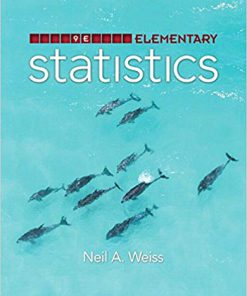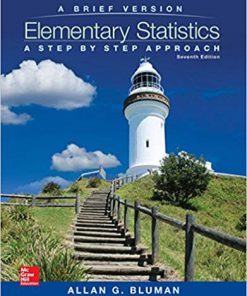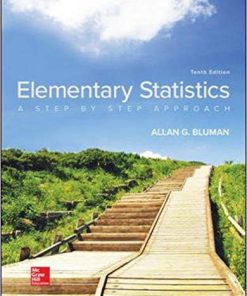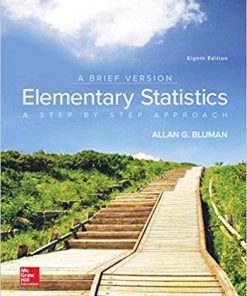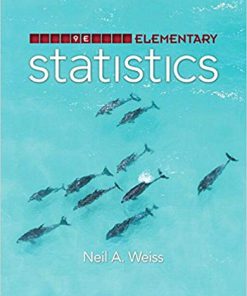Elementary Statistics: A Brief Version 8th Edition (eBook PDF)
$50.00 Original price was: $50.00.$35.00Current price is: $35.00.
Elementary Statistics: A Brief Version 8th Edition (eBook PDF) – Instant Download
Elementary Statistics: A Brief Version 8th Edition (eBook PDF) – Digital Ebook – Instant Delivery Download

product details:
- ISBN-10 : 1259969436
- ISBN-13 : 978-1259969430
- Author: Allan Bluman
Elementary Statistics: A Brief Version was written as an aid in the beginning Statistics course for students whose mathematical background is limited to basic algebra. The book follows a nontheoretical approach without formal proofs, explaining concepts intuitively and supporting them with abundant examples. The applications span a broad range of topics including problems in business, sports, health architecture, education, entertainment, political science, psychology, history, criminal justice, and many more. While a number of important changes have been made in this next edition, the learning system remains untouched and provides students with a useful framework in which to learn and apply concepts.
table of contents:
Chapter 1: The Nature of Probability and Statistics
1.1, Descriptive and Inferential Statistics
1.2, Variables and Types of Data
1.3, Data Collection and Sampling Techniques
1.4, Experimental Design
1.5, Computers and Calculators
Chapter 2: Frequency Distributions and Graphs
2.1, Organizing Data
2.2, Histograms, Frequency Polygons, and Ogives
2.3, Other Types of Graphs
2.4, Paired Data and Scatter Plots
Chapter 3: Data Description
3.1, Measures of Central Tendency
3.2, Measures of Variation
3.3, Measures of Position
3.4, Exploratory Data Analysis
Chapter 4: Probability and Counting Rules
4.1, Sample Spaces and Probability
4.2, The Addition Rules for Probability
4.3, The Multiplication Rules and Conditional Probability
4.4, Counting Rules
4.5, Probability and Counting Rules
Chapter 5: Discrete Probability Distributions
5.1, Probability Distributions
5.2, Mean, Variance, Standard Deviation, and Expectation
5.3, The Binomial Distribution
Chapter 6: The Normal Distribution
6.1, Normal Distributions
6.2, Applications of the Normal Distributions
6.3, The Central Limit Theorem
6.4, The Normal Approximation to the Binomial Distribution
Chapter 7: Confidence Intervals and Sample Size
7.1, Confidence Intervals
7.2, Confidence Intervals for the Mean When σ Is Known
7.3, Confidence Intervals for the Mean When σ Is Unknown
7.4, Confidence Intervals and Sample Size for Proportions
7.5, Confidence Intervals for Variances and Standard Deviations
Chapter 8: Hypothesis Testing
8.1, Steps in Hypothesis Testing – Traditional Method
8.2, z Test for a Mean
8.3, t Test for a Mean
8.4, z Test for a Proportion
8.5, Chi-Square Test for a Variance or Standard Deviation
8.6, Additional Topics Regarding Hypothesis Testing
Chapter 9: Testing the Difference Between Two Means, Two Proportions, and Two Variances
9.1, Testing the Difference Between Two Parameters
9.2, Testing the Difference Between Two Means: Using the z Test
9.3, Testing the Difference Between Two Means of Independent Samples: Using the t Test
9.4, Testing the Difference Between Two Means: Dependent Samples
9.5, Testing the Difference Between Two Proportions
9.6, Testing the Difference Between Two Variances
Chapter 10: Correlation and Regression
10.1, Correlation
10.2, Regression
10.3, Coefficient of Determination and Standard Error of the Estimate
Chapter 11: Chi-Square and Analysis of Variance (ANOVA)
11.1, Test for Goodness of Fit
11.2, Test Using Contingency Tables
11.3, Analysis of Variance (ANOVA)
people also search:
You may also like…
Mathematics - Mathematical Statistics
Elementary Statistics: Picturing the World, 8e 8th Edition Ron Larson – eBook PDF




